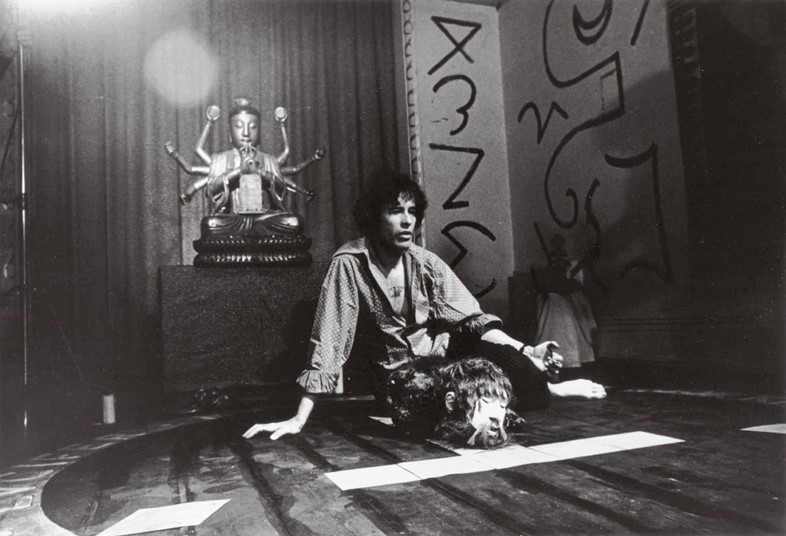As the antiques dealer and trailblazing dandy passes away, Paul Moody charts his enormous influence on 60s counterculture
- TextPaul Moody
60s counterculture would still have existed without Christopher Gibbs – who died this week, aged 79, in Tangier, Morocco – but it wouldn’t have been half as stylish. A broodingly handsome antiques dealer from upper class stock – he was educated at Eton and the Sorbonne – Gibbs was also a trailblazing dandy, credited with being the first man to wear flares as a fashion statement, on the King’s Road in 1961.
While he was at the centre of a louche Chelsea set – he was present at The Stones’ Redlands drug bust and was responsible for naming one of the era’s classic albums, Beggars Banquet – Gibbs’ major contribution to the decade was his unique approach to interior design. A heady mix of refinement, exoticism and faded grandeur, his unique style – dubbed “distressed bohemianism” by the New York Times – reached its fullest effect in his dazzling sets for Donald Cammell and Nic Roeg’s 1970 cult classic Performance.
None of which does justice to a fearless arbiter of wealth and taste who even Keith Richards once described as: “crazy…he was ready to jump into the unknown.” Here are five ways Gibbs helped make the 60s swing.
1. Men In Vogue
As editor of Men In Vogue between 1965 and 1970, Gibbs led from the front, taking centre stage in the ‘peacock revolution’ sweeping men’s fashion. “He was very flash,” wrote Nick Cohn in his book on British style, Today There Are No Gentlemen. “Mostly his tastes were elaborate; suits with double-breasted waistcoats and cloth-covered buttons, and velvet ties, and striped Turkish shirts with stiff white collars and cravats.” When Gibbs wasn’t wearing the above – usually accessorised with carnations with pink and yellow or purple and red flecks – he could be seen parading along the King’s Road in djellabas and chequered headscarves, brought back from his antique hunting trips to Morocco. “You had to be monumentally narcissistic and have time on your hands, and just about enough money to do it,” recalled Gibbs later.

2. 100 Cheyne Walk, Chelsea
By 1965, Gibb’s home at 100 Cheyne Walk had become a style salon for the hip elite. In a drawing room dominated by a vast Moroccan chandelier, the erudite and softly spoken Gibbs would introduce acolytes – including The Rolling Stones – to everything from fine wines to Islamic art. In the summer months, afternoon tea would be taken under a mulberry tree, in a garden designed by Lutyens. Used as set by both Antonioni (for 1966’s Blow Up) and Kenneth Anger (for 1971’s Lucifer Rising), one legendary party for the poet Allen Ginsberg saw guests including Princess Margaret enjoy potent hash brownies made by Gibbs. She was later hospitalised with what the palace called “severe food poisoning”.
3. Brian Jones’ South Kensington flat
Impressed by his visits to Cheyne Walk, The Stones guitarist asked Gibbs to furnish his new apartment at 1, Courtfield Road, SW7 in September 1966. With Moroccan tapestries covering the walls, cushions scattered across the floor and a large hookah pipe dominating the centre of the living room, Gibbs created the archetypal hippie crash pad. Here, Jones would hold court, entertaining guests including Bob Dylan, The Beatles and Jimi Hendrix. If anyone had the urge to play a tune, Jones would lead them to a secret minstrel’s gallery accessible by a rope ladder, packed with musical instruments.

4. Style Guru To The Stones
“I’m here to learn how to be a gentleman,” confided a young Mick Jagger to a fellow guest at one Cheyne Walk soirée, but Gibbs was much more than a useful associate. His high society contacts helped the singer enter the rarified social circle he craved, but he also introduced him to Prince Rupert Loewenstein, the band’s business manager and was an enthusiastic participant in The Stones’ drug taking proclivities. A night out in London with Keith Richards in 1968 ended in an impromptu road trip to Stonehenge, both high on LSD, while the guitarist marvelled at his friend’s capacity for hi-jinks in his autobiography, Life. “He’s the only guy I know who would wake up and break an amyl nitrate popper under his nose… he was an adventurous lad.” For Gibbs, the attraction was more straightforward, describing The Stones as “merry company, funny, irreverent and open-minded.”
5. Performance
“Performance was the dark and dazzling fruit of a fusion of skills and talents harnessed by Donald Cammell,” recalled Gibbs of his involvement in arguably the era’s most iconic movie, filmed in 1968. “My role was to conjure the setting of Turner’s/Mick’s exotic retreat – the world outside the world – where much of the drama was played out.” Gibbs achieved the effect of converting a Notting Hill basement into a Bedouin style lair by, as he put it, “sleuthing around film hire places” for threadbare sofas and groovy objet d’arts while importing exotic antiquities from Tangier. The tiled wall in the bathroom was inspired by a 16th century garden carpet the designer had seen in the V&A, while the bed where the main characters cavort was based on the story of the Princess and the Pea, with multi-coloured velvet-covered mattresses layered on top of one another. The precursor to – shudder – every ‘shabby chic’ coffee shop makeover since, it remains the interior design gold standard for anyone keen on decadent interiors.











